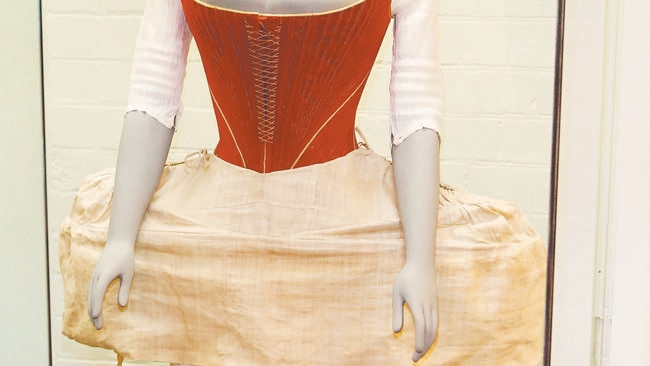Undressed at Powerhouse Museum puts 350 years of knickers in the spotlight
From a monarch’s drawers to a Vivienne Westwood corset, London’s iconic Victoria & Albert museum is sharing its treasured undies collection with Sydney.

For something that was designed to be hidden, underwear commands a lot of attention. From purely functional to decorative to political, it plays a surprisingly large part in history and pop culture.
The importance of undergarments can be seen in Undressed: 350 Years Of Underwear In Fashion, a travelling exhibition from London’s Victoria And Albert Museum that opens today at Sydney’s Powerhouse Museum.
Included in the exhibition are more than 80 garments from the renowned museum’s collection — including Queen Victoria’s drawers, an iron corset, as well as more recent acquisitions, such as a sheer red set from British lingerie label Agent Provocateur, co-founded in 1994 by Joseph Corré, the son of legendary designer Vivienne Westwood.
In conjunction with the V&A collection, the Powerhouse is showing 25 pieces from its own collection, including items from Bonds and Berlei, and Australia’s most famous dominatrix, Madame Lash.

Curator Glynis Jones says underwear is a perfect fit for the Powerhouse because it brings together the museum’s three tenets of art, design and technology.
“It’s that nexus that we embrace in this museum, across different disciplines. It explores the role of underwear across all three sections, as well as body image,” she says.
The items date back to the 1700s, when underwear was a purely practical item.
“It was about keeping outerwear garments clean,” Jones says.
“In the 1700s, people weren’t bathing every day and their other garments were made from fabric that was difficult to launder, so underwear was a layer that protected clothing from body fluids and was something you could change more often.”
While poorer folk stuck to simple, practical chemises, for wealther people undergarments became more elaborate and more constrictive — corsets, bustiers, crinolines and petticoats.
“Big hoops are hard to walk around in, so when you put the fabric of the dress over the hoop it becomes about the skirt of the fabric and shows off how wealthy you are,” Jones says. “You don’t need to worry about practicality because it shows you can afford to not work.”

The wide, exaggerated skirts may have signified wealth but they also presented a problem for the noble women who wore them.
“When getting in or out of a carriage, you had to lift up your skirts, so women started wearing drawers to maintain their modesty,” Jones says.
As Queen Victoria’s undergarments reveal, the drawers came complete with a slit in the fabric to make bathroom visits easier.
The corsets on display include a metal number that looks like medieval armour, a hot-pink style from the 1860s with a handspan waist, and a maternity corset, with press studs to help with breastfeeding, and side ties so that it could expand and contract with the body.

If corsets were meant to reduce a woman’s waist, then the idea of a maternity corset seems rather odd, but Jones says it was essential because some women could not support themselves without it.
“Children were corseted from a young age and, because of that, they didn’t develop the core muscles to stand up for long on their own,” she says.
This makes the practice of corsetry sound barbaric — a western version of footbinding — but Jones is philosophical.
“We look at corsetry and say ‘That’s terrible,’ but we now externalise it,” she says.
“Underwear was used to create an ideal body shape... Now we use cosmetic surgery to manipulate the body.”

The expectation that a woman’s body was to be manipulated into an ideal shape, which changed with the whims of fashion designers, fed into the women’s liberation movement and the so-called bra burning of the late-1960s andearly-1970s.
“It was done as an expression of freedom, of not being shackled,” Jones says.
But fashions have changed again and corsets are back, albeit in a new form.
“Shapewear is also part of the exhibition, as a modern corset,” Jones says.
And it’s not only for the girls — there’s also a male set from UK department store Marks & Spencer, which you can compare to a 1930s style, designed for gentlemen with a “portly stomach”.
Which goes to show, the desire to squeeze yourself
into society’s norms is something men and women have in common.
Twitter: @RenataGortan
â— Undressed: 350 Years Of Underwear In Fashion, Powerhouse Museum, 500 Harris St, Ultimo; until July 12, adult $15, conc/child $8, family $38, maas.museum
Originally published as Undressed at Powerhouse Museum puts 350 years of knickers in the spotlight




